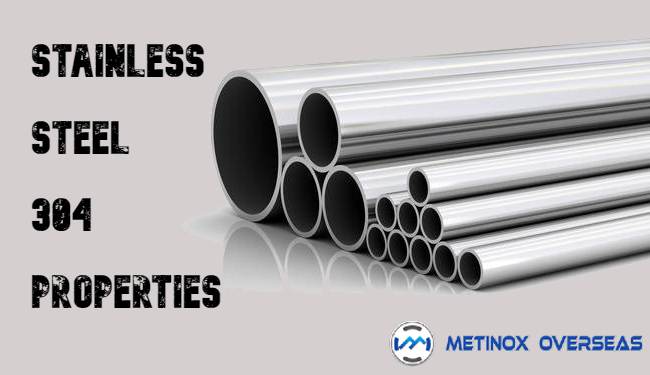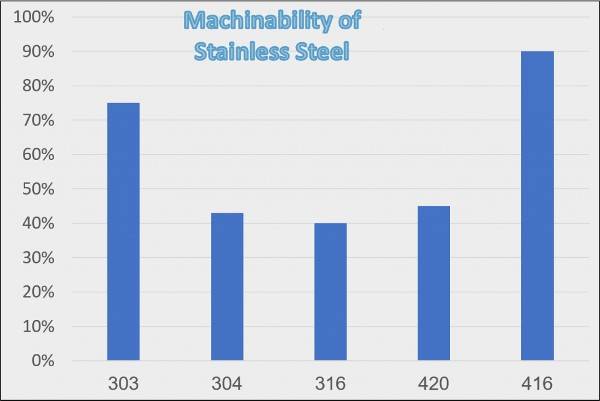Type 304 SS is one of the most common alloys. Stainless steel 304 is a low-cost alternative to 316 stainless steel. This low-cost material has excellent corrosion resistance, non-magnetic properties, and is very easy to machine. Its properties make it ideal for a number of industries, such as food processing and brewing equipment. Other common uses include pipelines, fermenting vats, storage and hauling tanks, railway cars, and pipelines. This alloy is also used extensively in the fruit juice industry. Learn more about its advantages and disadvantages to determine if it's right for your application. Below are a few of its main properties.

Average content by weight (%) of the major alloying elements most common Cr-Ni austenitic stainless steel 304. Source - Wikipedia
Stainless steel is an ideal corrosion-resistant material and it is a non-ferrous alloy with high chromium content (about 10%) but only if the grade is suitable for the application. While 304 is a good choice for many environments, 316 has superior chloride resistance. Both grades offer similar performance but 316 offers better corrosion resistance and is more expensive. Each application will determine the appropriate grade of stainless steel. Common consumer grades include 430, 409, and 416 and are also available in different tensile strengths and hardness of 304 SS. Its corrosion-resistant nature makes it the preferred material for many industrial applications, including pipelines, fermentation vats, surgical instruments, outdoor architectural features, storage tanks, railway cars, and food processing equipment.
304 stainless steel density is 7.93 g/cm3 (0.286 lb/in3). Density is defined as the mass divided by the volume. In addition to this, the International System of Units defines density in kilograms per cubic meter. This makes 304 stainless steel the ideal material for food-grade containers. However, its high density makes it susceptible to corrosion.
Reference
Stainless steel 304 a form of austenitic SS with a composition chromium and nickel. This material is highly machinable and weldable, making it an excellent choice for many industries including sheet metal fabrication due to SS 304 chemical composition alloys. Additionally, many people appreciate the aesthetic appearance of stainless steel 304, and it is often used in high-rise buildings. Also, being very durable, it also has excellent aesthetics.

Source
AISI 304 is high-quality stainless steel, with the characteristic of an austenitic structure. This is also known as 1.4301, V2A, or Austenitic Steel. 304 SS is non-magnetic in its annealed state. However, it can develop magnetic properties when cold work. Cold work transforms austenite into martensite, a phase which imparts magnetic properties, a change in its metallic crystal structure. Cold work will cause the steel to pick up iron particles and other foreign matter. It also dramatically increases 304 ss tensile and yield strengths.
This pipe will also become strongly magnetic when it is exposed to a magnet. Its nonmagnetic properties and lack of hardening by heat treatment make it ideal for a wide variety of machining tasks.
Compared to its 316 cousin, 304 stainless steel is slightly less expensive. It is also ideal for mild acids. Compared to 316, 304 is also easier to work with. However, each of these materials has unique compositions and mechanical properties. For example, 304 is less ductile than 316. In addition, 316 has molybdenum, titanium, and niobium.
Which steel sheet is best for your application? Stainless steel 304 or 316? This really depends on your needs and application. Although both stainless steels are almost identical, type 316 is harder and more corrosion resistant than its counterpart. The differences between the two are primarily in their makeup material. The former is hardened by heat treatment, whereas the latter cannot. In addition, 316 is slightly more expensive.
Various kinds make up the 300 Series stainless steel austenitic. These include 302 stainless as well as 304 stainless. Type 304 is utilized worldwide due to its attractive properties, like the resistance to corrosion and its excellent welding properties. Compared to other substances like copper, aluminum, and brass, 304 stainless is the most suitable for commercial and domestic use.

It is austenitic
Stainless steels are generally classified into five categories: austenitic, martensitic, precipitation-hardened, and ferritic.304 stainless steel is the most common type, less expensive alloy of austenitic stainless-steel and contains up to 18 per cent chromium by weight. Nickel helps it to retain its austenitic composition in high concentrations. The highest concentration of nickel is found in this type of stainless steel, while the remaining elements are carbon, nitrogen, and manganese. Various other elements are added to improve its corrosion resistance. This alloy is the least expensive in the 304 family, and is suitable for a wide variety of applications. These alloys have a high service life and low maintenance costs.
Average content by weight (%) of the major alloying elements most common Cr-Ni austenitic stainless steel 304. Source - Wikipedia
| Euronorm (EN) number | EN designation | AISI grade | C | Cr | Mo | Ni | Others | Melts at |
| 1.4301 | X5CrNi18-10 | 304 | < 0.07 | 18.5 | NS | 9 | NS | 1450 |
It is corrosion resistant
Stainless steel is an ideal corrosion-resistant material and it is a non-ferrous alloy with high chromium content (about 10%) but only if the grade is suitable for the application. While 304 is a good choice for many environments, 316 has superior chloride resistance. Both grades offer similar performance but 316 offers better corrosion resistance and is more expensive. Each application will determine the appropriate grade of stainless steel. Common consumer grades include 430, 409, and 416 and are also available in different tensile strengths and hardness of 304 SS. Its corrosion-resistant nature makes it the preferred material for many industrial applications, including pipelines, fermentation vats, surgical instruments, outdoor architectural features, storage tanks, railway cars, and food processing equipment.
304 Stainless Steel Property Chart Tables
| Physical Properties | Metric | English |
| Density | 8.00 g/cc | 0.289 lb/in3 |
304 stainless steel density is 7.93 g/cm3 (0.286 lb/in3). Density is defined as the mass divided by the volume. In addition to this, the International System of Units defines density in kilograms per cubic meter. This makes 304 stainless steel the ideal material for food-grade containers. However, its high density makes it susceptible to corrosion.
| Mechanical Properties | Metric | English |
| Hardness, Brinell | 123 | 123 |
| Hardness, Knoop | 138 | 138 |
| Hardness, Rockwell B | 70 | 70 |
| Hardness, Vickers | 129 | 129 |
| Tensile Strength, Ultimate | 505 MPa | 73200 psi |
| Tensile Strength, Yield | 215 MPa @Strain 0.200 % |
31200 psi @Strain 0.200 % |
| Elongation at Break | 70 % | 70 % |
| Modulus of Elasticity | 193 GPa | 28000 ksi |
| Poissons Ratio | 0.29 | 0.29 |
| Shear Modulus | 77.0 GPa | 11200 ksi |
| Izod Impact | 150 J @Temperature -195 0C |
111 ft-lb @Temperature -319 0F |
| 150 J @Temperature 21.0 0C |
111 ft-lb @Temperature 69.8 0F |
|
| Charpy Impact | 325 J | 240 ft-lb |
| Electrical Properties | Metric | English |
| Electrical Resistivity | 0.0000720 ohm-cm @Temperature 20.0 0C |
0.0000720 ohm-cm @Temperature 68.0 0F |
| 0.000116 ohm-cm @Temperature 650 0C |
0.000116 ohm-cm @Temperature 1200 0F |
|
| Magnetic Permeability | 1.020 | 1.020 |
| Thermal Properties | Metric | English |
| CTE, linear | 17.3 µm/m-0C @Temperature 0.000 - 100 0C |
9.61 µin/in-0F @Temperature 32.0 - 212 0F |
| 17.8 µm/m-0C @Temperature 0.000 - 315 0C |
9.89 µin/in-0F @Temperature 32.0 - 599 0F |
|
| 18.7 µm/m-0C @Temperature 0.000 - 650 0C |
10.4 µin/in-0F @Temperature 32.0 - 1200 0F |
|
| Specific Heat Capacity | 0.500 J/g-0C @Temperature 0.000 - 100 0C |
0.120 BTU/lb-0F @Temperature 32.0 - 212 0F |
| Thermal Conductivity | 16.2 W/m-K @Temperature 0.000 - 100 0C |
112 BTU-in/hr-ft2-0F @Temperature 32.0 - 212 0F |
| 21.5 W/m-K @Temperature 500 0C |
149 BTU-in/hr-ft2-0F @Temperature 932 0F |
|
| Melting Point | 1400 - 1455 0C | 2550 - 2651 0F |
| Solidus | 1400 0C | 2550 0F |
| Liquidus | 1455 0C | 2651 0F |
| Component Elements Properties | Metric | English |
| Carbon, C | <= 0.080 % | <= 0.080 % |
| Chromium, Cr | 18 - 20 % | 18 - 20 % |
| Iron, Fe | 66.345 - 74 % | 66.345 - 74 % |
| Manganese, Mn | <= 2.0 % | <= 2.0 % |
| Nickel, Ni | 8.0 - 10.5 % | 8.0 - 10.5 % |
| Phosphorus, P | <= 0.045 % | <= 0.045 % |
| Silicon, Si | <= 1.0 % | <= 1.0 % |
| Sulfur, S | <= 0.030 % | <= 0.030 % |
It is machinable
Stainless steel 304 a form of austenitic SS with a composition chromium and nickel. This material is highly machinable and weldable, making it an excellent choice for many industries including sheet metal fabrication due to SS 304 chemical composition alloys. Additionally, many people appreciate the aesthetic appearance of stainless steel 304, and it is often used in high-rise buildings. Also, being very durable, it also has excellent aesthetics.

Source
Is AISI 304 non-magnetic
AISI 304 is high-quality stainless steel, with the characteristic of an austenitic structure. This is also known as 1.4301, V2A, or Austenitic Steel. 304 SS is non-magnetic in its annealed state. However, it can develop magnetic properties when cold work. Cold work transforms austenite into martensite, a phase which imparts magnetic properties, a change in its metallic crystal structure. Cold work will cause the steel to pick up iron particles and other foreign matter. It also dramatically increases 304 ss tensile and yield strengths.
A heavily cold-drawn grade SS pipe 304 may reach tensile strengths of 2000 MPa.
This pipe will also become strongly magnetic when it is exposed to a magnet. Its nonmagnetic properties and lack of hardening by heat treatment make it ideal for a wide variety of machining tasks.
It is less expensive
Compared to its 316 cousin, 304 stainless steel is slightly less expensive. It is also ideal for mild acids. Compared to 316, 304 is also easier to work with. However, each of these materials has unique compositions and mechanical properties. For example, 304 is less ductile than 316. In addition, 316 has molybdenum, titanium, and niobium.
Stainless Steel 304 Vs 316
Which steel sheet is best for your application? Stainless steel 304 or 316? This really depends on your needs and application. Although both stainless steels are almost identical, type 316 is harder and more corrosion resistant than its counterpart. The differences between the two are primarily in their makeup material. The former is hardened by heat treatment, whereas the latter cannot. In addition, 316 is slightly more expensive.
Conclusion
Various kinds make up the 300 Series stainless steel austenitic. These include 302 stainless as well as 304 stainless. Type 304 is utilized worldwide due to its attractive properties, like the resistance to corrosion and its excellent welding properties. Compared to other substances like copper, aluminum, and brass, 304 stainless is the most suitable for commercial and domestic use.
Explore our Latest Stainless Steel Pipes Price, Pipe Weight Calculator, and Our Stainless Steel Pipes Grades today.
| SS Pipe Price | SS Pipe Weight Calculator | Contact Us |
